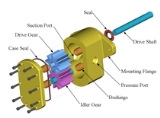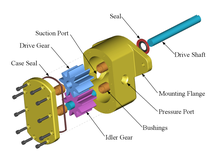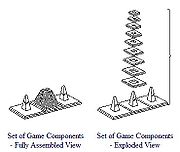
Exploded view
Encyclopedia

Diagram
A diagram is a two-dimensional geometric symbolic representation of information according to some visualization technique. Sometimes, the technique uses a three-dimensional visualization which is then projected onto the two-dimensional surface...
, picture or technical drawing
Technical drawing
Technical drawing, also known as drafting or draughting, is the act and discipline of composing plans that visually communicate how something functions or has to be constructed.Drafting is the language of industry....
of an object, that shows the relationship or order of assembly
Manufacturing
Manufacturing is the use of machines, tools and labor to produce goods for use or sale. The term may refer to a range of human activity, from handicraft to high tech, but is most commonly applied to industrial production, in which raw materials are transformed into finished goods on a large scale...
of various parts.
It shows the components of an object slightly separated by distance, or suspended in surrounding space in the case of a three-dimension
Dimension
In physics and mathematics, the dimension of a space or object is informally defined as the minimum number of coordinates needed to specify any point within it. Thus a line has a dimension of one because only one coordinate is needed to specify a point on it...
al exploded diagram. An object is represented as if there had been a small controlled explosion
Explosion
An explosion is a rapid increase in volume and release of energy in an extreme manner, usually with the generation of high temperatures and the release of gases. An explosion creates a shock wave. If the shock wave is a supersonic detonation, then the source of the blast is called a "high explosive"...
emanating from the middle of the object, causing the object's parts to be separated an equal distance away from their original locations.
The exploded view drawing is used in parts catalogs, assembly and maintenance manuals and other instructional material.
Usually, the projection of an exploded view is normally shown from above and slightly in diagonal from the left or right side of the drawing. (See exploded view drawing of a gear pump to the right). It is slightly from above and shown from the left side of the drawing in diagonal.
Overview

Exploded diagrams are common in descriptive manuals showing parts placement, or parts contained in an assembly or sub-assembly. Usually such diagrams have the part identification number and a label indicating which part fills the particular position in the diagram. Many spreadsheet
Spreadsheet
A spreadsheet is a computer application that simulates a paper accounting worksheet. It displays multiple cells usually in a two-dimensional matrix or grid consisting of rows and columns. Each cell contains alphanumeric text, numeric values or formulas...
applications can automatically create exploded diagrams, such as exploded pie charts.
In patent drawing
Patent drawing
A patent application or patent may contain drawings, also called patent drawings, illustrating the invention, some of its embodiments , or the prior art...
s in an exploded views the separated parts should be embraced by a bracket, to show the relationship or order of assembly of various parts are permissible, see image. When an exploded view is shown in a figure that is on the same sheet as another figure, the exploded view should be placed in brackets.
Exploded views can also be used in architectural drawing
Architectural drawing
An architectural drawing or architect's drawing is a technical drawing of a building that falls within the definition of architecture...
, for example in the presentation of landscape design. An exploded view can create an image in which the elements are flying through the air above the architectural plan
Architectural plan
An architectural plan is a plan for architecture, and the documentation of written and graphic descriptions of the architectural elements of a building project including sketches, drawings and details.- Overview :...
, almost like a cubist painting
Cubism
Cubism was a 20th century avant-garde art movement, pioneered by Pablo Picasso and Georges Braque, that revolutionized European painting and sculpture, and inspired related movements in music, literature and architecture...
. The locations can be shadowed or dotted in the siteplan of the elements.
History
Together with the cutaway view the exploded view was among the many graphic inventions of the RenaissanceRenaissance
The Renaissance was a cultural movement that spanned roughly the 14th to the 17th century, beginning in Italy in the Late Middle Ages and later spreading to the rest of Europe. The term is also used more loosely to refer to the historical era, but since the changes of the Renaissance were not...
, which were developed to clarify pictorial representation in a renewed naturalistic way. The exploded view can be traced back to the early fifteenth century notebooks of Marino Taccola
Taccola
Mariano di Jacopo detto il Taccola , called Taccola , was an Italian administrator, artist and engineer of the early Renaissance. Taccola is known for his technological treatises De ingeneis and De machinis, which feature annotated drawings of a wide array of innovative machines and devices...
(1382–1453), and were perfected by Francesco di Giorgio
Francesco di Giorgio
Francesco di Giorgio Martini was an Italian painter of the Sienese School and a sculptor, as well as being, in Nikolaus Pevsner's terms, "one of the most interesting later Quattrocento architects'" and a visionary architectural theorist; as a military engineer he executed architectural designs and...
(1439–1502) and Leonardo da Vinci
Leonardo da Vinci
Leonardo di ser Piero da Vinci was an Italian Renaissance polymath: painter, sculptor, architect, musician, scientist, mathematician, engineer, inventor, anatomist, geologist, cartographer, botanist and writer whose genius, perhaps more than that of any other figure, epitomized the Renaissance...
(1452–1519).
One of the first more clear examples of an exploded view created by Leonardo in his design drawing of a reciprocating motion
Reciprocating motion
Reciprocating motion, also called reciprocation, is a repetitive up-and-down or back-and-forth motion. It is found in a wide range of mechanisms, including reciprocating engines and pumps. The two opposite motions that comprise a single reciprocation cycle are called strokes...
machine. Leonardo applied this method of presentation in several other studies, including those on human anatomy.
The term "Exploded View Drawing" emerged in the 1940s, and is one of the first times defined in 1965 as "Three-dimensional (isometric) illustration that shows the mating relationships of parts, subassemblies, and higher assemblies. May also show the sequence of assembling or disassembling the detail parts."
See also
Similar types of technical drawings- Cross-sectionCross section (geometry)In geometry, a cross-section is the intersection of a figure in 2-dimensional space with a line, or of a body in 3-dimensional space with a plane, etc...
- Cutaway drawing
- PerspectivePerspective (graphical)Perspective in the graphic arts, such as drawing, is an approximate representation, on a flat surface , of an image as it is seen by the eye...

